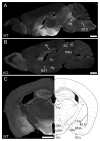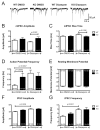Genetic markers of a Munc13 protein family member, BAIAP3, are gender specifically associated with anxiety and benzodiazepine abuse in mice and humans
- PMID: 23698091
- PMCID: PMC3745598
- DOI: 10.2119/molmed.2013.00033
Genetic markers of a Munc13 protein family member, BAIAP3, are gender specifically associated with anxiety and benzodiazepine abuse in mice and humans
Abstract
Anxiety disorders and substance abuse, including benzodiazepine use disorder, frequently occur together. Unfortunately, treatment of anxiety disorders still includes benzodiazepines, and patients with an existing comorbid benzodiazepine use disorder or a genetic susceptibility for benzodiazepine use disorder may be at risk of adverse treatment outcomes. The identification of genetic predictors for anxiety disorders, and especially for benzodiazepine use disorder, could aid the selection of the best treatment option and improve clinical outcomes. The brain-specific angiogenesis inhibitor I-associated protein 3 (Baiap3) is a member of the mammalian uncoordinated 13 (Munc13) protein family of synaptic regulators of neurotransmitter exocytosis, with a striking expression pattern in amygdalae, hypothalamus and periaqueductal gray. Deletion of Baiap3 in mice leads to enhanced seizure propensity and increased anxiety, with the latter being more pronounced in female than in male animals. We hypothesized that genetic variation in human BAIAP3 may also be associated with anxiety. By using a phenotype-based genetic association study, we identified two human BAIAP3 single-nucleotide polymorphism risk genotypes (AA for rs2235632, TT for rs1132358) that show a significant association with anxiety in women and, surprisingly, with benzodiazepine abuse in men. Returning to mice, we found that male, but not female, Baiap3 knockout (KO) mice develop tolerance to diazepam more quickly than control animals. Analysis of cultured Baiap3 KO hypothalamus slices revealed an increase in basal network activity and an altered response to diazepam withdrawal. Thus, Baiap3/BAIAP3 is gender specifically associated with anxiety and benzodiazepine use disorder, and the analysis of Baiap3/BAIAP3-related functions may help elucidate mechanisms underlying the development of both disorders.
Figures




References
-
- Kessler RC, et al. Lifetime prevalence and age-of-onset distributions of DSM-IV disorders in the National Comorbidity Survey Replication. Arch Gen Psychiatry. 2005;62:593–602. - PubMed
-
- Pasche S. Exploring the comorbidity of anxiety and substance use disorders. Curr Psychiatry Rep. 2012;14:176–81. - PubMed
-
- Conway KP, Compton W, Stinson FS, Grant BF. Lifetime comorbidity of DSM-IV mood and anxiety disorders and specific drug use disorders: results from the National Epidemiologic Survey on Alcohol and Related Conditions. J Clin Psychiatry. 2006;67:247–57. - PubMed
-
- Myrick H, Brady K. Current review of the comorbidity of affective, anxiety, and substance use disorders. Curr Opin Psychiatry. 2003;16:261–70.
Publication types
MeSH terms
Substances
LinkOut - more resources
Full Text Sources
Other Literature Sources
Medical
Molecular Biology Databases
Research Materials

